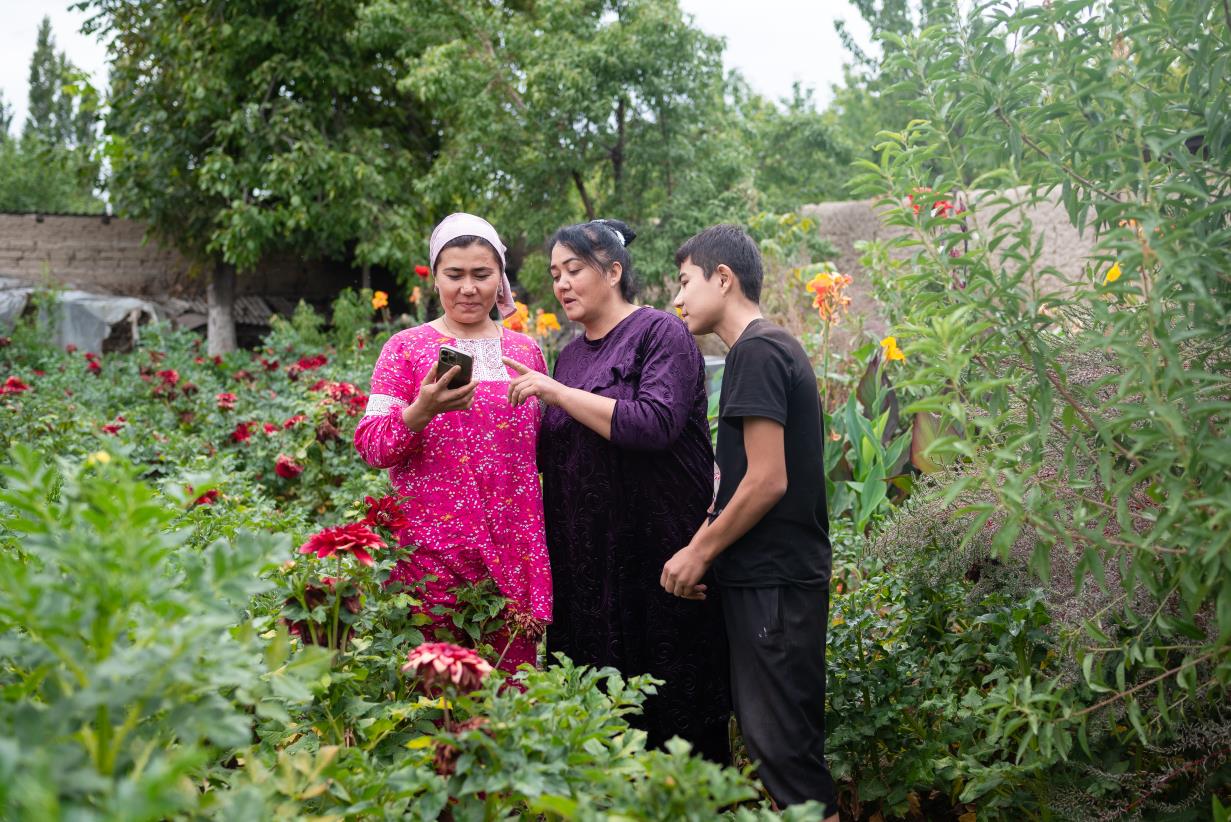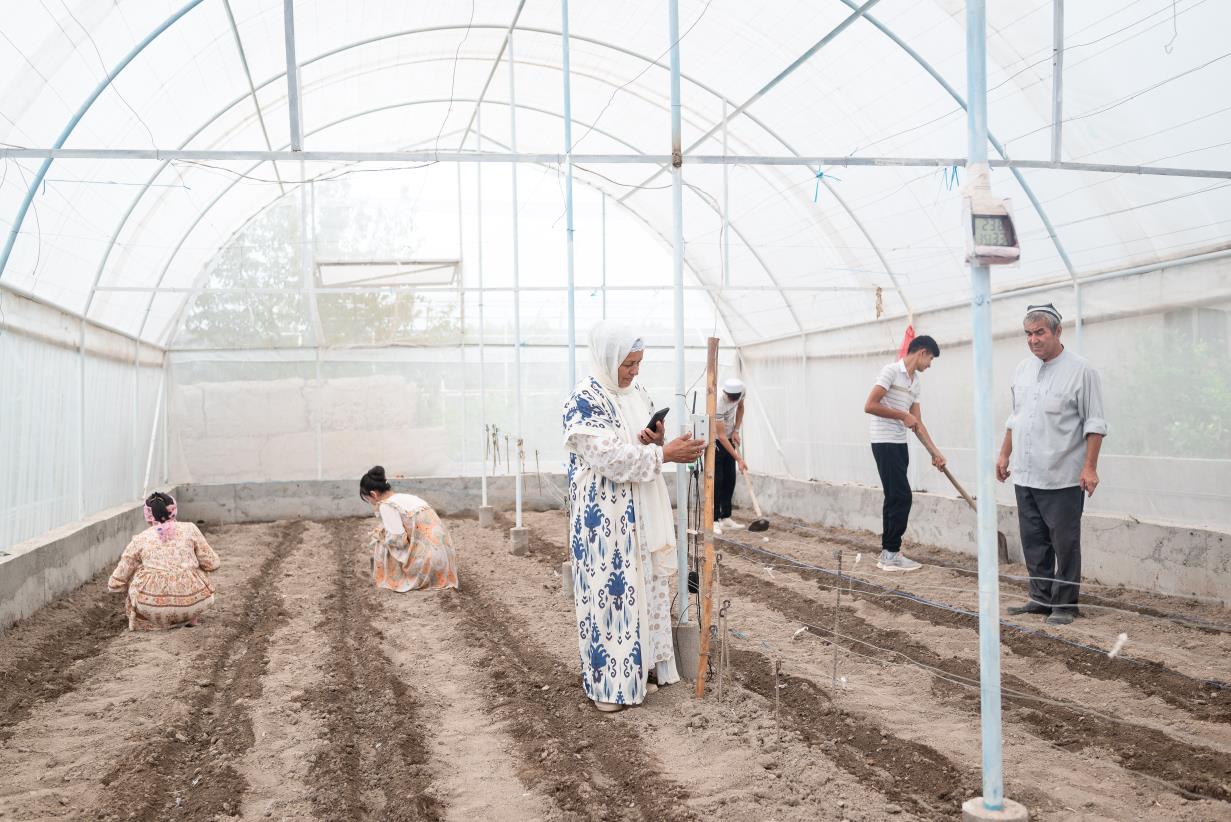
Embracing change with the Digital Villages Initiative in Uzbekistan
The use of technology in agriculture is encouraging active youth participation in learning and transforming traditional agricultural practices. ©FAO/Daniil Dolidze
06/09/2023
In the heart of the Fergana Valley, Shaodatkhon Oripova, a 62-year-old mother of three, combats the challenges of rural farming with modern technology. Embracing the power of the internet of things, she exemplifies the transformative wave that the Digital Villages Initiative of the Food and Agriculture Organization of the United Nations (FAO) brings to farming communities in Uzbekistan.
Shaodatkhon is a farmer who owns a greenhouse and fields that produce herbs, tomatoes, lemons, maize, and clover.
“I was born into a family of farmers, and I have been a farmer my whole life, but it has not been easy,” she said.
Shaodatkhon has faced several challenges as a smallholder, with problems surrounding water scarcity, changing climate conditions, and rising production costs. Navigating these hurdles, she often has found her income being drained by necessities rather than being able to spend her money on growth opportunities.
“In the past,” she said, “a lot of my earnings would disappear into paying for water bills and buying fertilizers.”
However, with the introduction of digital sensors connected to the internet, Shaodatkhon has managed to better control temperature, humidity, light, and soil moisture in her now-smart greenhouse. This has contributed to improvements in irrigation, ventilation and pesticide use, leading to increased production and lower costs.


In July 2023 in Novkent, FAO held a living lab dedicated to women farmers, with various generations coming together to cook and discuss their unique challenges. ©FAO/Daniil Dolidze
“Every day I learn new ways to work with technology,” she said. “Being notified remotely when something needs to be adjusted in the greenhouse has given us more time for other things.”
Shaodatkhon is one of the beneficiary farmers of FAO's ‘Smart farming for the future generations’ project and the Digital Villages Initiative, which was introduced to the villages of Novkent and Yuksalish in the Fergana Valley of Uzbekistan earlier this year.
The Digital Villages Initiative is a flagship programme of FAO with the goal of converting at least 1 000 villages around the world into digital village hubs. The initiative aims to foster rural transformation and empower communities through digitalization and participatory approaches to combat hunger, poverty, and inequality to achieve the Sustainable Development Goals (SDGs).
As part of the initiative, farmers from Novkent and Yuksalish participated in several interviews, focus groups, and workshops to share their current needs and challenges and to identify the strengths and local assets that can be leveraged in the digital village transformation process. This work helped in the drafting of a road map with interventions that already have helped improve the lives of villagers such as Shaodatkhon.
Among these interventions are the introduction of high-quality – yet low-cost – devices for greenhouse monitoring, the dissemination of innovative agricultural practices via a “digital hub,” and a comprehensive capacity-development plan that encompasses digital skill and entrepreneurship training and the use of digital solutions in agriculture.
The digital hub’s social media channels (including Telegram and YouTube) serve as a platform for sharing credible and easily digestible agricultural knowledge and information tailored to the needs of farmers and for exchanging knowledge in the community and beyond.
Innovation, youth involvement, and community engagement are key pillars of the digital village transformation process.
Innovation, youth involvement, and community engagement are key pillars of the digital village transformation process. Young people are trained to replicate internet of things devices and encouraged to find innovative solutions to community problems.
Through an upcoming Digital Villages Hackathon, participants from various backgrounds can propose innovative solutions to benefit the rural communities in the Fergana Valley and further encourage youth participation in the agriculture sector.
The communities – and especially their more vulnerable people – are at the centre of these innovation process. During regular “living labs,” farmers such as Shaodatkhon and her family can discuss the challenges they face – including water scarcity and a lack of infrastructure and reliable extension services – and brainstorm solutions with community members, local and regional administrators, members of the private sector, research institution representatives, and other specialists in agriculture and technology.
“Living labs are changing the way the community is perceiving the challenges they face,” said Asqarali Azizov, the head of Novkent village. “Farmers have developed a more positive attitude towards responding to the problems affecting them and, most importantly, feel that they can do something and react to them. During one of the living lab meetings, an adept farmer identified a resolution to a challenge in farming that had been brought up by another farmer. This is a good result.”

As a beneficiary farmer of the FAO Digital Villages Initiative, Shaodatkhon now uses smart sensors to control temperature, humidity, light and soil conditions in her greenhouse. ©FAO/Daniil Dolidze
In Novkent and Yuksalish villages, technology is slowly becoming a larger part of rural livelihoods. Despite the difficulties that come with change, the introduction of technology has prompted villages to explore new methods of farming and knowledge transfer. Incorporating technology into everyday practices requires taking risks, investing resources, and learning continuously. Nevertheless, communities have understood that they can be a part of the solution by working with others.
“Seeing the positive change the smart sensors brought to the farming practices of farmers in Novkent village, other farmers have developed interest in installing such devices in their greenhouses,” Asqarali Azizov said.
Shaodatkhon’s story highlights the impact of digital technologies can have on the livelihoods of smallholders in villages throughout the region and beyond. She is an example of how access to technology can help boost production in rural farming and improve the overall livelihoods of vulnerable populations.
FAO is scaling up the Digital Villages Initiative in Central Asia and beyond, working closely with rural communities to understand their most pressing problems and desired outcomes, identify the appropriate agricultural technologies for the community, and support them in becoming active in their digital rural transformation journeys.
In the coming months, FAO will continue in its efforts to offer training programmes for both farmers and youth in Novkent and Yuksalish. An internet of things camp will help train local youth in replicating smart sensor devices, and the Digital Villages Hackathon – on the calendar for November – aims to innovate agritech solutions to the challenges faced by rural people in the Fergana Valley. The continuation of regular living labs will also provide a vital platform for feedback exchange among farmers, experts, and innovators.
Shaodatkhon’s journey in Novkent stands as a testament to the transformative power of innovation and technology in converting rural communities into Digital Villages. The work in Uzbekistan is a benchmark for FAO as it prepares to scale up the initiative in Albania, Azerbaijan, Bosnia and Herzegovina, Georgia, Kyrgyzstan, Tajikistan, and Türkiye.
- Digital Villages Initiative in Europe and Central Asia
- Digital village hubs can transform quality of life in rural Europe and Central Asia
- Smart Farming in Uzbekistan
- Tajikistan on the road to digital agriculture
- Digitalizing cows in Georgia
- Livestock industry in Central Asia looks into digital solutions to build resilience
